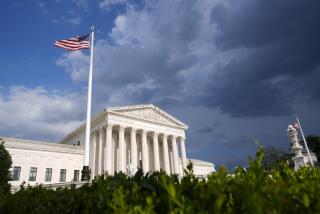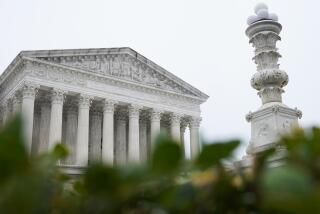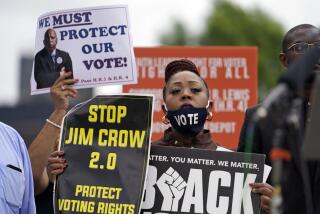Supreme Court gives North Carolina Republicans a delay in partisan gerrymander case
The Supreme Court came to the aid of North Carolina’s Republican leaders Thursday, putting on hold a lower court’s ruling that declared the state’s election map an unconstitutional “partisan gerrymander” and required the GOP-controlled Legislature to redraw congressional districts in time for this year’s election.
The justices granted an emergency appeal that blocks enforcement of the Jan. 9 decision by a three-judge panel rebuking Republican leaders.
Justices Ruth Bader Ginsburg and Sonia Sotomayor dissented.
The court’s decision will put the case on hold until the justices rule on at least one of two partisan gerrymandering cases currently before them.
The justices are already in the midst of an internal battle over the constitutionality of partisan line-drawing, involving a case from Wisconsin, which was brought by Democrats, and a case from Maryland brought by Republicans. The outcome could affect the political battle for control of the House in the November elections. Partisan gerrymandering has helped the GOP control the House for most of this decade.
The North Carolina case led to an unusually strong condemnation of partisan line-drawing. The three-judge panel that ruled against the state’s map would have required the Legislature to draw new districts in two weeks.
Those judges ruled the state’s election map was unconstitutional because it was deliberately drawn to give the GOP a lopsided 10-3 grip on the state’s delegation in the U.S. House of Representatives. The best evidence of this partisan bias came from the mouths of the state’s Republican leaders, the judges said.
“I think electing Republicans is better than electing Democrats,” State Rep. David Lewis, the GOP leader of the state Assembly, said two years ago when the district lines were being redrawn. “We want to make clear that to extent we are going to use political data in drawing this map, it is to gain partisan advantage,” he said, adding that is “not against the law.”
He would have gone further, Lewis said, but “I do not believe it’s possible to draw a map with 11 Republicans and 2 Democrats.”
In recent elections, the state’s votes have been closely split between Republicans and Democrats, but Republicans have maintained the 10-3 majority in congressional seats.
Two years after Democrats celebrated Barack Obama’s winning the White House, Republicans in 2010 swept to big victories in midterm elections and took control in several “purple” states, including Pennsylvania, Ohio, Wisconsin and North Carolina. Armed with new census data and better computer programs, GOP leaders were able to draw election maps that aimed to make sure their candidates would hold the majority for a decade in the state legislatures and the House.
Pennsylvania sends 13 Republicans and five Democrats to the House, while Ohio sends 12 Republicans and four Democrats.
North Carolina has a long history of legal disputes over its election maps. Two years ago, lawmakers there were forced to make some changes because two districts were struck down as racial gerrymanders. Judges pointed to evidence that Republicans had moved tens of thousands of black voters into districts that already had regularly elected an African American Democrat.
In devising a remedy for that racial line-drawing, GOP leaders said they would redraw the map to maintain their “partisan advantage.”
That in turn prompted new lawsuits by Common Cause and the League of Women Voters. Lawyers for the two groups argued that the partisan tilt denied voters the equal protection of the laws and discriminated against them based on their political viewpoints in violation of the 1st Amendment.
They added a new argument that might appeal to those who look to the original meaning of the Constitution of 1787. Article 1 created the House of Representatives and said its members shall be “chosen every second Year by the People of the several states.” By contrast, senators were to be selected by state legislatures, and the president would be chose by a vote of state electors in a system that came to be known as the electoral college.
Common Cause lawyers argued it is unconstitutional for the state legislature, rather than “the People,” to effectively decide which party’s candidate will be elected to the House.
The three-judge court issued a 205-page opinion in the North Carolina case and agreed with the challengers on all three constitutional claims.
Major questions before the Supreme Court this year »
On Twitter: DavidGSavage
More to Read
Get the L.A. Times Politics newsletter
Deeply reported insights into legislation, politics and policy from Sacramento, Washington and beyond. In your inbox three times per week.
You may occasionally receive promotional content from the Los Angeles Times.











